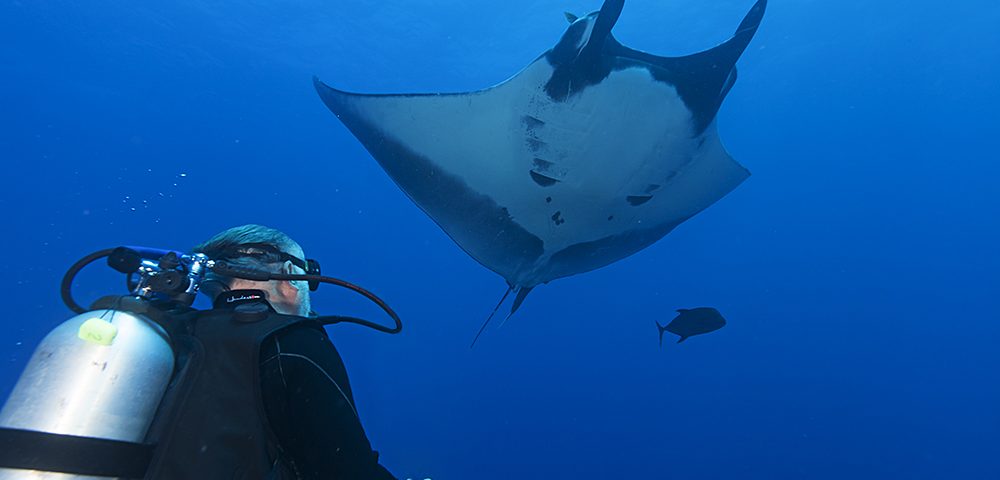
Photo is by Claudio Contraras-Koob taken in March 2017 during a Manta Citizen Science Expedition with Dr. Bob Rubin – Mantas are identified by the markings on their underbelly
PACIFIC MANTA RESEARCH GROUP
The Pacific Manta Research Group has conducted field research on the Oceanic Manta Ray for over three decades in the Gulf of California, the Revillagigedo Archipelago and Banderas Bay in the Mexican Pacific. Their findings have been chronicled in multiple educational documentaries and viewed widely by international audiences. The results of their work have been presented to the broad scientific community and to the Government of Mexico which have contributed to the establishment and further expansion of a habitat and species protection for manta rays and other members of the larger pelagic community of marine animals, including sharks and whales. The outcomes were important in the decision by UNESCO to designate the Revillagigedo Archipelago as a World Heritage site, in June 2016.
The photos used in this research have been generously contributed by interested divers who are passionate about these magnificent creatures, their habitat, and their future. The project would not be possible without the selfless goodwill and efforts of scores of concerned divers and photographers. The use of underside images of mantas enables us to identify individual animals, and follow their movements and fate over time. PMRG now recognizes 750+ individuals with over a third (280+) of which have been re-sighted. Fifteen have been sighted multiple times over periods in excess of 20 years and the longevity record is 28 years for this species.
You can participate in this research by being a contributor. Your help is invaluable, and your images will be used exclusively for scientific purposes. When used, we will credit your authorship and inform you about our scientific and conservation progress.
"Everyone traveling to Revillagigedo should submit their images to the Pacific Manta Research Group. One photograph may not seem like much to offer to such a
large project, but the ripples that image can send out could be massive. Citizen scientists/photographers offer a huge help to researchers studying the giant
mantas. The more images that can be cataloged the better. Don’t let your photographs sit stagnant on your computers at home – give them to the great group of
people at PMRG and help them do some good for the animals of Revillagigedo.”
– Contributing photographer Bryce Groark – LivingOceanProductions.com
PLEASE JOIN US IN AN INTERNATIONAL EFFORT TO STUDY, CONSERVE AND PROTECT THESE CHARISMATIC ANIMALS AND THEIR HABITAT
Pacific Manta Research Group focuses on the manta rays of the Eastern Pacific, including the Revillagigedo Archipelago, the Gulf of California, and Banderas Bay, Mexico. Our photo-ID database reaches from 1978 to the present, with over 650 individuals identified, of which 250+ have been seen more than once.
PACIFIC MANTA RESEARCH GROUP
Physical Address:
UC Davis Bodega Marine Laboratory
2099 Westshore Road, Bodega Bay, California 94923
(707) 875-2071
(707) 527-4250
bobdrubin@gmail.com
Manta.birostris1@gmail.com
elasmobranch.manta@gmail.com
Robert Rubin, Ph.D. – Director PMRG
BobDRubin@gmail.com
Karey Kumli, B.A. – Project Manager PMRG
manta.birostris1@gmail.com
www.Facebook.com/PacificMantaResearchGroup
https://pacificmantaresearchgroup.shutterfly.com/
BECOMING INVOLVED IN MANTA RESEARCH
We welcome you to become a contributor to our project! Your help is invaluable, and your images will be used exclusively for scientific purposes. When used, we will credit your authorship and inform you about our scientific and conservation progress.
For complete details, visit https://pacificmantaresearchgroup.shutterfly.com/photo-identification
Thank you for joining ourselves and others in efforts to understand, protect and conserve these "flying carpets of ebony silk".
We are grateful for your donations: https://santarosajc.ejoinme.org/?tabid=507553M
MANTA AND MOBULAM
The family to which manta rays belong, contains two species of manta and nine different mobula rays, also known as “devil rays” for the horn-like head appendages they use in foraging on small zooplankton and for sensory perception. The oceanic manta ray (Manta birostris) is considered to be among the most recently appearing cartilaginous fish (five million years) in the world’s oceans and the most highly advanced members of the approximately 1100 species of elasmobranch fish, including the sharks, skates, rays and the little-known chimaeras.
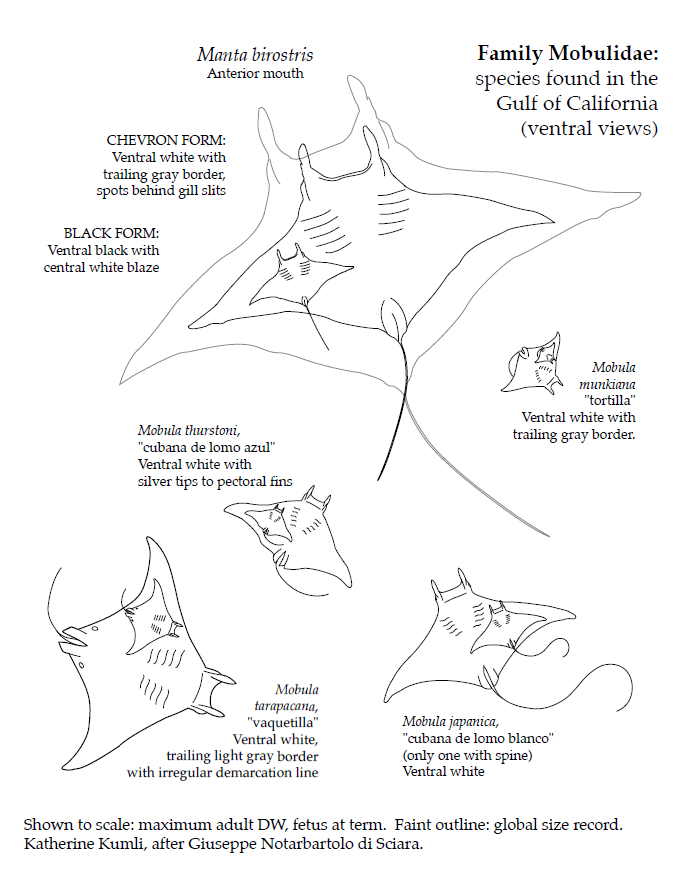
MANTA MORPHS / FORMS
Unlike most populations elsewhere in the world, these animals display two color forms. Unrelated to either sex or size, the chevron and black forms occur in a 3:1 ratio respectively. Similar to human fingerprints, both forms exhibit unique ventral markings specific to individuals. Quality photographic images/videos of the ventral surface patterns are used to identify, track and cataloge animals.
CONTRIBUTORS & COLLEAGUES
"It takes a village" to conduct field research of this magnitude. The Pacific Manta Research Group owes its success to the collaborative efforts and goodwill we have received from scores of divers, Roberto Chavez, Alfonso Trujillo, Mike McGettigan, Sherry Shaffer, Valeria Mas, AMISUB, the crews and owners of Rocio del Mar and Quino el Guardian, Drs. Mauricio Hoyos, James Ketchum, Gavin Chilcott, and Felipe Galvan, and many others, to whom we are forever grateful.

"We understand far less about the nature of marine habitats than about those on land. We understand infinitely less about the world’s oceans than we do about stellar space. We understand that in the sea we learn the language of another world. One that may allow us to survive in this one."
– Robert Rubin
A FEW EXAMPLES OF IDENTIFIED MANTAS
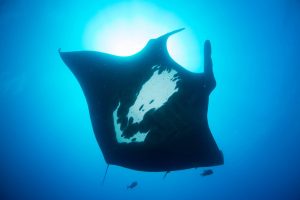
Black manta Spike was named for the white chest mark’s resemblance to the hairstyle of the 90s. Shy of cameras since 2009, this manta did pose last month for Marie-Elizabeth Mali, who was the only one in the group to make this discovery. This find illustrates the concept that we don’t all see the same animals! When you return to the boat after a dive, do compare your images with those of the other divers, and in this way you will see all the mantas. You don’t want to miss anything!
March 2016
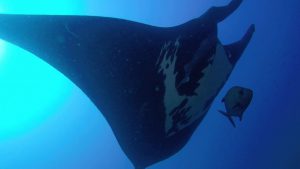
This lovely manta with the lacy patterns just got a name – Katrin – we hope this is a female manta, and want all of you divers to keep watchful and let us know. This photo was taken by Joel Ibarra, November 2012 at Socorro’s Cabo Pierce, and at San Benedicto’s in February 2015 by Divecooky. That’s not a speed record for a 20-mile crossing, but it is another indication that mantas use the unprotected water between islands. Thanks to photographers who have documented these crossings, we have momentum towards protecting the inter-island waters. Another great reason to submit your manta photos!
January 2016
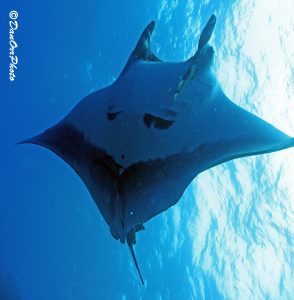
We often are excited when a manta appears in your photos who was known long, long ago, and absent for some time. Today we are excited about just the opposite: manta Braam, photographed by Mary O’Malley for the first time last February, and again by Dan Orr in May, was sighted in November of 1997 and we have just received the images. This wonderful retroactive resighting underscores the importance of you, the photographer, sending us your historical images.
January 2016
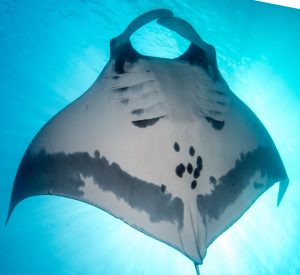
Resighted female manta Damai, I’m happy to present you to our Facebook audience! Damai was seen in March 2007, and not again until February of this year. Thanks to Mary O’Malley for this resighting!
October 2015

